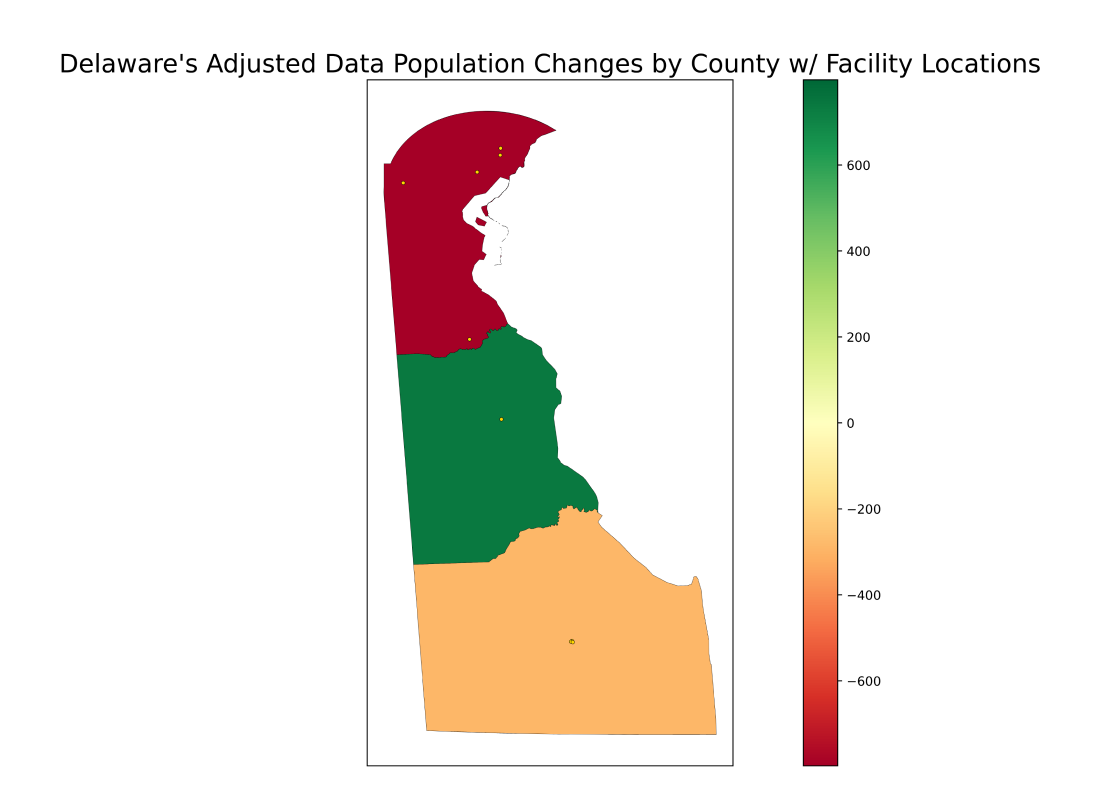
Used for state legislative and state congressional redistricting
The expanded report provides a detailed breakdown of the PL 94-171 data as released by the Census Bureau, compared to the reallocated, or adjusted data, provided by the state’s official redistricting body.
Specifically, this report details the differences in total population by census block, block group, tract, county, and state before and after reallocation. In states where comparisons are possible, these population differences are broken down by race and ethnicity.
DownloadDelaware uses adjusted (or modified) data for state legislative redistricting.
Even in states where where the total population is unchanged, the distribution of population within the state can be affected.
To give you a sense for how these population shifts affect Delaware’s redistricting, the average district sizes in Delaware are:
The dataset used to create this report is the official redistricting dataset.
See the appendix for a detailed breakdown of county level population changes.

In general, the changes in block population are not uniform: most blocks are unaffected by adjustment, while a handful of blocks lose a large amount of population that goes to a larger number of blocks in smaller quantities.
| Population Change | Number of Blocks |
|---|---|
| Gained 100+ | 0 |
| Gained 51-100 | 0 |
| Gained 11-50 | 5 |
| Gained 6-10 | 35 |
| Gained 1-5 | 2,296 |
| No Change | 17,854 |
| Lost 1-5 | 0 |
| Lost 6-10 | 0 |
| Lost 11-50 | 1 |
| Lost 51-100 | 3 |
| Lost 100+ | 4 |
The official language for Delaware’s adjustment is:
(a) The General Assembly, in determining the reapportionment and redistricting for the State, applying the criteria set forth in § 804 of this title, and using the official reporting of the federal decennial census as set forth in § 805 of this title, shall not count as part of the population in a given district boundary any incarcerated individual who: (1) Was incarcerated in a state or federal correctional facility, as determined by the decennial census; and (2) Was not a resident of the State before the person’s incarceration. (b) The General Assembly, in determining the reapportionment and redistricting for the State as provided in this subchapter, shall count as part of the population in a given district boundary any individual incarcerated in a state or federal correctional facility, as determined by the decennial census, if the individual was a resident of the State prior to incarceration. Such individual shall be counted for reapportionment and redistricting purposes at the individual’s last known residence prior to incarceration. (c) This section shall not apply to the redistricting of the State following the 2010 federal decennial census. This section shall apply to the redistricting of the State following each federal decennial census thereafter.
| County | Population Change |
|---|---|
| Kent | 737 |
| Sussex | -289 |
| New Castle | -798 |